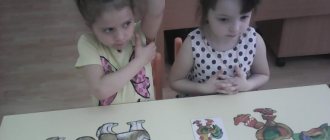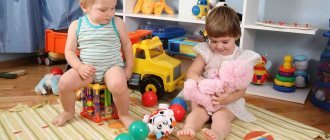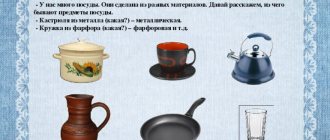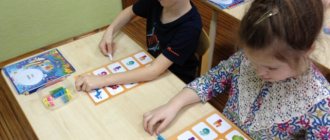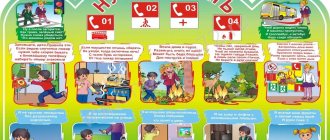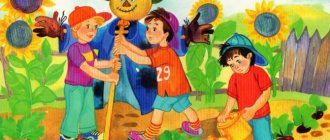Making pictures from parts
There is a lot of literature on this topic, I use these manuals:
- Children's health kit;
- A set of pictures on social development
- Illustrations on children's speech activity.
I also use homemade materials in my work, download pictures from the Internet and make games. So, that was a small digression, let's get back to the topic of conversation.
A drawing that is divided along straight lines into several parts is split. A preschooler should not think about the shape of a detail in a drawing; he concentrates on the full image.
When a child collects a drawing, he must imagine what he is collecting, what image he will get. In this case, he must correlate the pieces with the image so that the correct place is allocated to it. Otherwise the illustration will not work. This requires concentration, seriousness, and attentiveness from children.
When folding cut images, the baby begins to realize the objective integrity and compose an illustration from parts. He trains his memory, develops thinking, and spatial orientation. Drawings are great for improving fine motor skills. By consolidating knowledge about objects and phenomena, assembling a whole from pieces, the goal of the cut-out pictures game is formed.
From simple to complex
At first it is better to use the simplest designs with a small number of individual pieces. The image should be familiar to the baby. A good option is two similar pictures, one of which is divided into 2 parts. In this case, one can be a sample.
After the child masters this fun, he will not need an example picture. For this game, drawings from coloring books or old books will be useful. It will be much more interesting if you draw them yourself. Use bright, but not irritating colors.
First, cut the images into two, then into three parts. Then increase the number of pieces gradually when the child folds the previous drawing on his own. You should know that the number of elements collected increases, and their size decreases. There are times when a baby puts together pictures with large pieces easier.
The number of items should be selected in accordance with the age and special qualities of your child.
Cubes
Composite pictures on cubes have their own peculiarity associated with the shape of the cube. A fragment located on each face is no longer just part of a flat image. To get the picture, it is not enough to put the cube in its place, it needs to be turned the right way. Composite pictures on the cubes suggest the presence of a basic understanding of the cube. This type of composite pictures fulfills its developmental task for children from 3-4 to 6-7 years old. You need to start your acquaintance with four cubes, on which there is an image of a separate object (fruit, dog, car, etc.). When offering a game, all the cubes need to be turned with one picture facing up - this simplifies the task, the baby just needs to place them in the correct order. As the child masters this game, the task needs to be complicated: first, turn one cube the wrong way and ask the child to find the missing part of the picture on it, then do the same with two cubes, with three. Gradually the child will get used to this game.
Now he can be offered a plot image in pictures (for example, a scene from a familiar fairy tale).
What are the benefits of cubes? Many of them are made in the same style, for example, on all sides there are scenes from fairy tales, and on three sides events taking place in the hut are depicted, and on the other three - in the forest; all sides are painted in the same color scheme. Therefore, sometimes it is not easy even for an adult to determine at first glance whether the cube is turned the right way. To avoid mistakes, you need to be very careful and patient.
Important points when choosing cubes: unity of style, color scheme, similarity of plot and age-appropriate level of difficulty. It is precisely these cubes that will most effectively fulfill their developmental task.
Cutting pictures for kindergarten
Very often in kindergarten I involve older children in making such games for younger children, and preschoolers are happy to help me. But at the same time, I am pursuing my goals, my task is not only to attract a child to artistic work, but also to teach how to cut paper, while developing children’s hands and fingers.
Pay attention to the “Games” section, where you will find a lot of useful material.
The game of cut pictures is widely used in speech therapy activities with preschool children of the middle and senior groups. A speech therapist works with them and uses these games in his work.
At every age, starting from 1.5 - 3 and continuing up to 7 years, the child is very interested in this fun, because with the help of it he learns the alphabet, toys, professions, transport, etc.
For preschoolers in the preparatory group, it is interesting to conduct such fun activities in mathematics. When compiling examples, I use the following pictures: in the upper part, for example, animals, toys or any objects, and in the lower part there is a number with the number of objects depicted in the picture. Such cut-out pictures for preschoolers can also be used to compose problems. An important indicator for assessing intellectual development in children is the success of putting together pictures from parts.
Insert pictures
The insert picture is a picture with parts cut out. You need to find the missing pieces and put them in their places to create a complete image. For example, a drawing of a fruit bowl in which individual fruits are cut out. This game is intended for children from 2 to 4 years old. Its task can be expressed by the question “what is missing here?” Usually, children as young as two years old can easily cope with inserts, for example, with a row of vegetables and fruits or a row of dogs of the same shape, but of different sizes.
Thus, classes with insert pictures are very good for the formation and development of visual-figurative thinking that is just emerging in the baby.
It is necessary to choose insert pictures based on the age of the child: the younger he is, the fewer pieces should be cut out, and the larger the details.
In the simplest version of this game, the cut out fragment has smooth edges, and the design depicted on it is symmetrical (for example, a symmetrical daisy on a square piece). Or the shape of the piece matches the image: a cut out cup, saucer, spoon, etc. In these cases, in order to cope with the task, the child simply needs to understand which part of the picture this element is from. To complicate the task, you can offer your child a picture with uneven edges of the cutouts that do not coincide with the boundaries of the picture.
It is even more difficult for a child to cope with a picture, the cut-out parts of which have smooth edges, but the image located on them is asymmetrical: for example, a bird is drawn on a square - the child has to be careful not to put it upside down. Or each piece does not represent a separate image, but only a part of it, for example, a fragment of a vase or flower. Here the child is forced to focus on the shape of the cutout and the corresponding piece (we insert a circle into a round cutout, a triangle into a triangular cutout), and also take into account the content of what is drawn, correlate the details of the image, all the lines, colors and location of the drawing. These insert pictures are especially difficult for a child due to age characteristics, and at some stage he will need the help of an adult. However, such games prepare the basis for the successful development of visual and figurative thinking. The experience gained will allow the child to more easily cope with much more complex puzzles.
Method of playing the game
Having carried out the technique with cut-out drawings, for example, according to the seasons, you must first select pictures on this topic. The purpose of this method is to identify the skills of composing a whole image from parts. The task is to orientate by shape, color, size, identify visual figurative thinking, coordinate hand movements, as well as fine motor skills. How to do this fun?
Before playing the game, the speech therapist lays out parts of the illustration, which consist of 4 parts, on tables for children. Then he invites the children to assemble the object, asks them to put the parts on the sample, remember the location of the parts in order to assemble the illustration themselves. After which the drawings are scattered, the sample is removed, inviting the children to collect them again. The child must name the object that is cut.
If a child puts the images together correctly on the first try, this means that his visual and figurative effective thinking is well formed. If a small child completed the task on the second attempt, then we can assume that his attention and imagination are poorly formed.
In a word, this technique helps the baby develop logic, memory, attention, imagination, thinking, activates speech and sensory perception.
Coloring pages
To conduct classes on the topic “Toys” it is also very useful to use thematic coloring books. They help the child not only learn and remember all kinds of names of objects for games, but also practice using a large number of descriptive adjectives (in descriptions of various colors and materials). A correctly selected coloring book is a real helper for speech therapists and parents!
Recommendations for parents
Cutting pictures for children develop their sensory abilities.
The tasks for adult groups are:
- development of the baby’s sensory abilities: restoration of the whole in parts;
- development of coordinated actions of hands and eyes through the ability to trace an image along a contour;
- knowledge of the object depicted in the illustration, its name and finding identical drawings;
- speech development, enrichment of the active vocabulary with the help of new words, as well as repetitions of familiar words.
The materials are object drawings from two sets. Two identical images are selected from each set. One picture is cut in half, and the other, as an example for selection, remains intact.
Tip #1
Use pictures that, when cut, form identical parts, connecting them, they will be like one whole, for example, a hare, a pyramid, a car, a chicken.
How to conduct classes? Use a surprise moment, let a fairy-tale character come to visit your son or daughter who does not know the names of the toys. For example: a clown drew toys and brought them to your baby so that he could tell what they are and how to play with them. Parents show entire illustrations and ask what is depicted on them. If the children answer correctly, you praise him. It will be good if you use a poem or beautiful figures of speech on the topic of the image.
Don’t forget that children get tired quickly, spend some physical exercise in a playful way, fortunately there are a great many of them on the Internet.
When a preschooler looks at the drawings, an adult teaches him the ability to trace an object along the contour. Thus, sensory actions of the hands and eyes are developed, which help to recognize objects when examining their shape.
Next, the parent shows the same illustrations, which consist of two identical halves. Then he explains that the picture must be folded correctly, then you will get a whole pyramid, matryoshka or car. Then he shows how to add two identical halves, and also compares the created illustration with a similar image in the whole drawing that the clown brought them.
Then the task becomes a little more complicated, the parent gives the child 2 drawings, for example, a pyramid and a hare, a car and a chicken, a tomato and a cucumber. The child chooses images from two options that differ in color and shape. When classes are over, the adult praises the little one for the actions done.
Tip #2
Dear parents, to consolidate the material, you need to systematically repeat the lessons and further complicate them, i.e. cut illustrations into three, four, eight parts.
The game cut pictures for preschoolers allows them to get acquainted with their hometown, learn the names of domestic and wild animals, migratory birds and insects, indoor plants, flowers, trees, vegetables, fruits. It also helps to improve cognitive interests in fire safety and military equipment.
5/5 — (3 votes)
